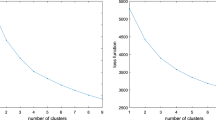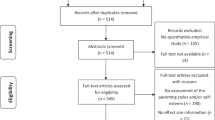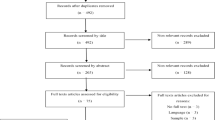Abstract
Parents of a child with autism spectrum disorder (ASD) face specific challenges in parenting, but concrete parenting behavior has never been properly investigated in these families. This exploratory questionnaire study compared parenting behaviors among mothers of children and adolescents with ASD (n = 552) and without ASD (n = 437) and examined associations between child behavior problems and parenting behavior. Results showed that mothers of children with ASD reported significantly lower scores on Rules and Discipline and higher scores on Positive Parenting, Stimulating the Development, and Adapting the Environment. Age was differently related to parenting behavior in the ASD versus control group. Furthermore, distinctive correlation patterns between parenting behavior and externalizing or internalizing behavior problems were found for both groups.

Similar content being viewed by others
References
American Psychiatric Association. (2000). Diagnostic and statistical manual of mental disorders (4th ed., text revision). Washington, DC: APA.
Barbaresi, W. J., Katusic, S. K., & Voigt, R. G. (2006). Autism: A review of the state of science for pediatric primary health care clinicians. Archives of Pediatrics and Adolescent Medicine, 160, 1167–1175. doi:10.1001/archpedi.160.11.1167.
Barber, B. K., Stolz, H. E., & Olsen, J. A. (2005). Parental support, psychological control, and behavioral control: Assessing relevance across time, culture, and method. Monographs of the Society for Research in Child Development, 70, 1–137.
Beauchaine, T., Webster-Stratton, C., & Reid, M. J. (2005). Mediators, moderators, and predictors of 1-year outcomes among children treated for early-onset conduct problems: A latent growth curve analysis. Journal of Consulting and Clinical Psychology, 73, 371–388. doi:10.1037/0022-006X.73.3.371.
Berg-Nielsen, T. S., Vikan, A., & Dahl, A. A. (2002). Parenting related to child and parental psychopathology: A descriptive review of the literature. Clinical Child Psychology and Psychiatry, 7, 529–552. doi:10.1177/1359104502007004006.
Bernier, R., Gerdts, J., Munson, J., Dawson, G., & Estes, A. (2012). Evidence for broader autism phenotype characteristics in parents from multiple-incidence autism families. Autism Research, 5, 13–20. doi:10.1002/aur.226.
Burke, J. D., Pardini, D. A., & Loeber, R. (2008). Reciprocal relationships between parenting behavior and disruptive psychopathology from childhood through adolescence. Journal of Abnormal Child Psychology, 36, 679–692. doi:10.1007/s10802-008-9219-7.
Burrell, T. L., & Borrego, J. (2012). Parents’ involvement in ASD treatment: What is their role? Cognitive and Behavioral Practice, 19, 423–432. doi:10.1016/j.cbpra.2011.04.003.
Caron, A., Weiss, B., Harris, V., & Catron, T. (2006). Parenting behavior dimensions and child psychopathology: Specificity, task dependency, and interactive relations. Journal of Clinical Child and Adolescent Psychology, 35, 34–45. doi:10.1207/s15374424jccp3501_4.
Carothers, D. E., & Taylor, R. L. (2004). How teachers and parents can work together to teach daily living skills to children with autism. Focus on Autism and Other Developmental Disabilities, 19, 102–104. doi:10.1177/10883576040190020501.
Chevallier, C., Kohls, G., Troiani, V., Brodkin, E. S., & Schultz, R. T. (2012). The social motivation theory of autism. Trends in Cognitive Sciences, 16, 231–239. doi:10.1016/j.tics.2012.02.007.
Cohen, J. (1988). Statistical power analysis for the behavioral sciences. Hillsdale, NJ: Lawrence Erlbaum.
Collins, W. A. (1990). Parent-child relationships in the transition to adolescence: Continuity and change in interaction, affect, and cognition. In R. Montemayor, G. R. Adams, & T. P. Gullota (Eds.), From childhood to adolescence: A transitional period? Advance in adolescent development: An annual book series (Vol. 2, pp. 85–106). Thousand Oaks, CA: Sage Publications.
Cummings, E. M., Davies, P. T., & Campbell, S. (2000). Developmental psychopathology and family process: Theory, research and clinical implications. New York: Guilford.
Estes, A., Munson, J., Dawson, G., Koehler, E., Zhou, X.-H., & Abbott, R. (2009). Parenting stress and psychological functioning among mothers of preschool children with autism and developmental delay. Autism, 13, 375–387. doi:10.1177/1362361309105658.
Finkenauer, C., Engels, R., & Baumeister, R. (2005). Parenting behavior and adolescent behavioral and emotional problems: The role of self-control. International Journal of Behavioral Development, 29, 58–69. doi:10.1080/01650250444000333.
Gardner, F., Hutchings, J., Bywater, T., & Whitaker, C. (2010). Who benefits and how does it work? Moderators and mediators of outcome in an effectiveness trial of a parenting intervention. Journal of Clinical Child and Adolescent Psychology, 39, 568–580. doi:10.1080/15374416.2010.486315.
Gavidia-Payne, S., & Hudson, A. (2002). Behavioral supports for parents of children with an intellectual disability and problem behaviours: An overview of the literature. Journal of Intellectual and Developmental Disability, 27, 31–55.
Gilotty, L., Kenworthy, L., Sirian, L., Black, D. O., & Wagner, A. E. (2002). Adaptive skills and executive function in autism spectrum disorders. Child Neuropsychology, 8, 241–248. doi:10.1076/chin.8.4.241.13504.
Goodman, R. (1997). The Strengths and Difficulties Questionnaire: A research note. Journal of Child Psychology and Psychiatry, 38, 581–586. doi:10.1111/j.1469-7610.1997.tb01545.x.
Goodman, A., Lamping, D. L., & Ploubidis, G. B. (2010). When to use broader internalizing and externalizing subscales instead of the hypothesised five subscales on the Strengths and Difficulties Questionnaire (SDQ): Data from British parents, teachers and children. Journal of Abnormal Child Psychology, 38, 1179–1191. doi:10.1007/s10802-010-9434-x.
Gray, K., Keating, C., Taffe, J., & Brereton, A. (2012). Trajectory of behavior and emotional problems in autism. American Journal on Intellectual and Developmental Disabilities, 117, 121–133. doi:10.1352/1944-7588-117-2.121.
Hastings, R. P. (2002). Parental stress and behavior problems of children with developmental disabilities. Journal of Intellectual and Developmental Disability, 27, 149–160. doi:10.1080/1366825021000008657.
Howlin, P. (1998). Practitioner review: Psychological and educational treatments for autism. Journal of Child Psychology and Psychiatry, 39, 307–322. doi:10.1111/1469-7610.00327.
Ingersoll, B. R., & Wainer, A. L. (2011). Pilot study of a school-based parent training program for preschoolers with ASD. Autism,. doi:10.1177/1362361311427155.
Kanne, S. M., & Mazurek, M. O. (2011). Aggression in children and adolescents with ASD: Prevalence and risk factors. Journal of Autism and Developmental Disorders, 41, 926–937. doi:10.1007/s10803-010-1118-4.
Kawabata, Y., Alink, L. R. A., Tseng, W.-L., Van IJzendoorn, M. H., & Crick, N. R. (2011). Maternal and paternal parenting styles associated with relational aggression in children and adolescents: A conceptual analysis and meta-analytic review. Developmental Review, 31, 240–278. doi:10.1016/j.dr.2011.08.001.
Krasny, L., Williams, B. J., Provencal, S., & Ozonoff, S. (2003). Social skills interventions for the autism spectrum: Essential ingredients and a model curriculum. Child and Adolescent Psychiatric Clinics of North America, 12, 107–122. doi:10.1016/S1056-4993(02)00051-2.
Laible, D. J., Carlo, G., & Raffaelli, M. (2000). The differential relations of parent and peer attachment to adolescent adjustment. Journal of Youth and Adolescence, 29, 45–59. doi:10.1023/A:1005169004882.
Lambrechts, G., Van Leeuwen, K., Boonen, H., Maes, B., & Noens, I. (2011). Parenting behavior among parents of children with autism spectrum disorder [corrected]. Research in Autism Spectrum Disorders, 5, 1143–1152. doi:10.1016/j.rasd.2010.12.011.
Lecavalier, L., Leone, S., & Wiltz, J. (2006). The impact of behavior problems on caregiver stress in young people with autism spectrum disorders. Journal of Intellectual Disability Research, 50, 172–183. doi:10.1111/j.1365-2788.2005.00732.x.
Lucyshyn, J. M., Albin, R. W., Horner, R. H., Mann, J. C., Mann, J. A., & Wadsworth, G. (2007). Family implementation of positive behavior support for a child with autism: Longitudinal, single-case, experimental, and descriptive replication and extension. Journal of Positive Behavior Interventions, 9, 131–150. doi:10.1177/10983007070090030201.
Lucyshyn, J. M., Binnendyk, L., Fossett, B., Cheremshynski, C., Lohrmann, S., Elkinson, L., et al. (2009). Toward an ecological unit of analysis in behavioral assessment and intervention with families of children with developmental disabilities. In W. Sailor, G. Dunlap, G. Sugai, & R. Horner (Eds.), Handbook of positive behavior support: Issues in child clinical psychology (pp. 73–106). New York: Springer.
Lucyshyn, J. M., Irvin, L. K., Blumberg, E. R., Laverty, R., Horner, R. H., & Sprague, J. R. (2004). Validating the construct of coercion in family routines: Expanding the unit of analysis in behavioral assessment with families of children with developmental disabilities. Research and Practice for Persons with Severe Disabilities, 29, 104–121. doi:10.2511/rpsd.29.2.104.
Matson, J. L., Benavidez, D. A., Compton, L. S., Paclawskyj, T., & Baglio, C. (1996). Behavioral treatment of autistic persons: A review of research from 1980 to the present. Research in Developmental Disabilities, 17, 433–465. doi:10.1016/S0891-4222(96)00030-3.
Mazurek, M. O., & Kanne, S. M. (2010). Friendship and internalizing symptoms among children and adolescents with ASD. Journal of Autism and Developmental Disorders, 40, 1512–1520. doi:10.1007/s10803-010-1014-y.
McGovern, C. W., & Sigman, M. (2005). Continuity and change from early childhood to adolescence in autism. Journal of Child Psychology and Psychiatry, 46, 401–408. doi:10.1111/j.1469-7610.2004.00361.x.
Mesibov, G. B., Schopler, E., & Hearsey, K. (1994). Structured teaching. In E. Schopler & G. B. Mesibov (Eds.), Behavioral issues in autism (pp. 195–211). New York: Plenum.
Muris, P., Meesters, C., & Van den Berg, F. (2003). The Strengths and Difficulties Questionnaire (SDQ): Further evidence for its reliability and validity in a community sample of Dutch children and adolescents. European Child and Adolescent Psychiatry, 12, 1–8. doi:10.1007/s00787-003-0298-2.
O’Neill, R. E., Horner, R. H., Albin, R. W., Sprague, J. R., Storey, K., & Newton, J. S. (1997). Functional assessment and program development for problem behavior: A practical handbook. Pacific Grove, CA: Brooks.
Osborne, L. A., & Reed, P. (2010). Stress and self-perceived parenting behaviors of parents of children with autistic spectrum conditions. Research in Autism Spectrum Disorders, 4, 405–414. doi:10.1016/j.rasd.2009.10.011.
Ozonoff, S., Young, G. S., Carter, A., Messinger, D., Yirmiya, N., Zwaigenbaum, L., et al. (2011). Recurrence risk for autism spectrum disorders: A baby siblings research consortium study. Pediatrics, 128, e488–e495. doi:10.1542/peds.2010-2825.
Patterson, G. R. (1982). Coercive family process: A social interactional approach (Vol. 3). Eugene, OR: Castalia Publishing Company.
Patterson, G. R., Reid, J., & Dishion, T. (1992). Antisocial boys. A social interactional approach (Vol. 4). Eugene, OR: Castalia Publishing Company.
Reese, R. M., Richman, D. M., Belmont, J. M., & Morse, P. (2005). Functional characteristics of disruptive behavior in developmentally disabled children with and without autism. Journal of Autism and Developmental Disorders, 35, 419–428. doi:10.1007/s10803-005-5032-0.
Reid, J. B., Patterson, G. R., & Snyder, J. J. (Eds.). (2002). Antisocial behavior in children and adolescents: A developmental analysis and model for intervention. Washington, DC: American Psychological Association.
Repp, A., & Horner, R. H. (Eds.). (1999). Functional analysis of problem behavior: From effective assessment to effective support. Belmont, CA: Wadsworth.
Ruser, T. F., Arin, D., Dowd, M., Putnam, S., Winklosky, B., Rosen-Sheidley, B., et al. (2007). Communicative competence in parents of children with autism and parents of children with specific language impairment. Journal of Autism and Developmental Disorders, 37, 1323–1336. doi:10.1007/s10803-006-0274-z.
Seltzer, M. M., Krauss, M. W., Orsmond, G. I., & Vestal, C. (2001). Families of adolescents and adults with autism: Uncharted territory. International Review of Research in Mental Retardation, 23, 267–294. doi:10.1016/S0074-7750(00)80014-2.
Seltzer, M. M., Shattuck, P., Abbeduto, L., & Greenberg, J. S. (2004). Trajectory of development in adolescents and adults with autism. Mental Retardation and Developmental Disabilities Research Reviews, 10, 234–247. doi:10.1002/mrdd.20038.
Shattuck, P. T., Seltzer, M. M., Greenberg, J. S., Orsmond, G. I., Bolt, D., Kring, S., et al. (2007). Change in autism symptoms and maladaptive behaviors in adolescents and adults with an autism spectrum disorder. Journal of Autism and Developmental Disorders, 37, 1735–1747. doi:10.1007/s10803-006-0307-7.
Siller, M., & Sigman, M. (2002). The behaviors of parents of children with autism predict the subsequent development of their children’s communication. Journal of Autism and Developmental Disorders, 32, 77–89. doi:10.1023/A:1014884404276.
Simonoff, E., Pickles, A., Charman, T., Chandler, S., Loucas, T., & Baird, G. (2008). Psychiatric disorders in children with autism spectrum disorders: Prevalence, comorbidity, and associated factors in a population-derived sample. Journal of the American Academy of Child and Adolescent Psychiatry, 47, 921–929. doi:10.1097/CHI.0b013e318179964f.
Soenens, B., Vansteenkiste, M., Lens, W., Luyckx, K., Goossens, L., Beyers, W., et al. (2007). Conceptualizing parental autonomy support: Adolescents perceptions of promotion of independence versus promotion of volitional functioning. Developmental Psychology, 43, 633–646. doi:10.1037/0012-1649.43.3.633.
Steinberg, L. (1990). Interdependency in the family: Autonomy, conflict, and harmony in the parent-adolescent relationship. In S. Feldman & G. Elliott (Eds.), At the threshold: The developing adolescent (pp. 255–276). Cambridge, MA: Harvard University Press.
Sturmey, P., Seiverling, L., & Ward-Horner, J. (2008). Assessment of challenging behaviors in people with autism spectrum disorders. In J. L. Matson (Ed.), Clinical assessment and intervention for autism spectrum disorders (pp. 131–156). Burlington, MA: Elsevier.
Tabachnick, B. G., & Fidell, L. S. (2007). Using multivariate statistics (5th ed.). Boston: Pearson.
Taylor, J. L., & Seltzer, M. M. (2011). Employment and post-secondary educational activities for young adults with autism spectrum disorders during transition to adulthood. Journal of Autism and Developmental Disorders, 41, 566–574. doi:10.1007/s10803-010-1070-3.
Thomas, K. C., Ellis, A. R., McLaurin, C., Daniels, J., & Morrissey, J. P. (2007). Access to care for autism-related services. Journal of Autism and Developmental Disorders, 37, 1902–1912. doi:10.1007/s10803-006-0323-7.
Tomanik, S., Harris, G. E., & Hawkins, J. (2004). The relationship between behaviors exhibited by children with autism and maternal stress. Journal of Intellectual and Developmental Disability, 29, 16–26. doi:10.1080/13668250410001662892.
Van Leeuwen, K., Meerschaert, T., Bosmans, G., De Medts, L., & Braet, C. (2006). The Strengths and Difficulties Questionnaire in a community sample of young children in Flanders. European Journal of Psychological Assessment, 22, 189–197. doi:10.1027/1015-5759.22.3.189.
Van Leeuwen, K. G., Mervielde, I., Braet, C., & Bosmans, G. (2004). Child personality and parental behavior as moderators of problem behavior: Variable- and person-centered approaches. Developmental Psychology, 40, 1028–1046. doi:10.1037/0012-1649.40.6.1028.
Van Leeuwen, K., & Noens, I. (2013). Parental Behavior Scale for autism spectrum disorders. Unpublished document, Leuven: KU Leuven.
Van Leeuwen, K. G., & Vermulst, A. A. (2004). Some psychometric properties of the Ghent Parental Behavior Scale. European Journal of Psychological Assessment, 20, 283–298. doi:10.1027/1015-5759.20.4.283.
Van Leeuwen, K., & Vermulst, A. (2010). Handleiding bij de Verkorte Schaal voor Ouderlijk Gedrag [manual of the short version of the Parental Behavior Scale]. Unpublished document, Leuven: KU Leuven.
Wachtel, K., & Carter, A. S. (2008). Reaction to diagnosis and parenting styles among mothers of young children with ASDs. Autism, 12, 575–594. doi:10.1177/1362361308094505.
Weiss, B., Dodge, K. A., Bates, J. E., & Pettit, G. S. (1992). Some consequences of early harsh discipline: Child aggression and a maladaptive social information processing style. Child Development, 63, 1321–1335. doi:10.1111/j.1467-8624.1992.tb01697.x.
Welterlin, A., Turner-Brown, L. M., Harris, S., Mesibov, G., & Delmolino, L. (2012). The home teaching program for toddlers with autism. Journal of Autism and Developmental Disorders, 42, 1827–1835. doi:10.1007/s10803-011-1419-2.
Whitaker, P. (2002). Supporting families of preschool children with autism: What parents want and what helps. Autism, 6, 411–426. doi:10.1177/1362361302006004007.
Wood, J. J., McLeod, B. D., Sigman, M., Hwang, W. C., & Chu, B. C. (2003). Parenting and childhood anxiety: Theory, empirical findings, and future directions. Journal of Child Psychology and Psychiatry and Allied Disciplines, 44, 134–151. doi:10.1111/1469-7610.00106.
Acknowledgments
This research was funded by grants from the Marguerite-Marie Delacroix Support Fund, the Research Council of the KU Leuven (IDO/08/013), and the Fund for Scientific Research Flanders (FWO). Furthermore, we thank all the participating families and schools, as well as the Flemish and Dutch parent associations for ASD.
Conflict of interest
The authors declare that they have no conflict of interest.
Author information
Authors and Affiliations
Corresponding author
Rights and permissions
About this article
Cite this article
Maljaars, J., Boonen, H., Lambrechts, G. et al. Maternal Parenting Behavior and Child Behavior Problems in Families of Children and Adolescents with Autism Spectrum Disorder. J Autism Dev Disord 44, 501–512 (2014). https://doi.org/10.1007/s10803-013-1894-8
Published:
Issue Date:
DOI: https://doi.org/10.1007/s10803-013-1894-8




